Corsican language
Corsican (corsu [ˈkorsu], [ˈkɔrsu]; full name: lingua corsa [ˈliŋɡwa ˈkorsa], [ˈkɔrsa]) is a Romance language from the Italo-Dalmatian family that is spoken predominantly on the Mediterranean island of Corsica (France). Corsican is closely related to the Tuscan varieties from the Italian peninsula, and therefore to the Florentine-based standard Italian.
| Corsican | |
|---|---|
| corsu, lingua corsa | |
| Pronunciation | [ˈkorsu], [ˈkɔrsu] |
| Native to | France Italy |
| Region | Corsica Sardinia (Maddalena archipelago) |
Native speakers | 150,000 in Corsica (2013)[1] |
| Dialects | |
| Latin script (Corsican alphabet) | |
| Official status | |
Recognised minority language in | |
| Regulated by | No official regulation |
| Language codes | |
| ISO 639-1 | co |
| ISO 639-2 | cos |
| ISO 639-3 | cos – Corsican |
| Glottolog | cors1241 Corsicansass1235 Sassarese Sardinian |
| ELP | Corsican[3] |
| Linguasphere | 51-AAA-p |
 | |
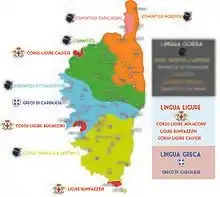 Linguistic map of Corsica | |
Under the longstanding sway of Pisa and Genoa over Corsica, Corsican used to play the role of a vernacular in combination with Italian, which was the island's official language; in 1859, Italian was replaced by French, owing to the French acquisition from the Republic of Genoa in 1768. Over the next two centuries, the use of French in the place of Italian grew to the extent that, by the Liberation in 1945, all the islanders had a working knowledge of French. The 20th century saw a language shift, with the islanders changing their language practices to the extent that there were no monolingual Corsican speakers left by the 1960s. By 1995, an estimated 65 percent of islanders had some degree of proficiency in Corsican,[4] and a minority, amounting to around 10 percent, used Corsican as a first language.[5]
Some languages that originated from Corsican but are also heavily influenced by Sardinian, and are nowadays considered to be languages on their own, are also spoken, and to some extent written, on the island of Sardinia (Italy).[6]
Classification by subjective analysis
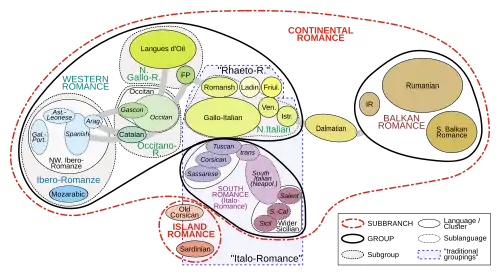
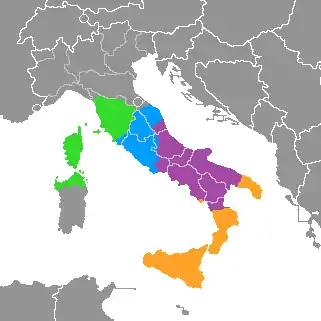
Tuscan dialects, including standard Italian Middle Italian dialects (Central Italian) Intermediate Southern Italian dialects (Neapolitan) Extreme Southern Italian dialects (Sicilian)
As for Corsican, a bone of contention is whether it should be considered an Italian dialect or its own language. Usually, it is not possible to ascertain what an author means by these terms. For example, one might read from some scholars that Corsican belongs to the Centro-Southern Italian dialects and is closely related to Italy's Tuscan, if not reputed to be part of thereof.[8][9][10] Mutual intelligibility between Italian and the dialects of Corsican is in fact very high, with particular reference to the Northern varieties. Despite the geographical proximity, it has indeed been noted that the closest linguistic neighbour to Corsican is not Sardinian, which constitutes a separate group, but rather Tuscan and the extreme Southern Italian lects like Siculo-Calabrian.[11]
The matter is controversial, as the island was historically and culturally bound to the Italian Mainland from the Middle Ages until the 19th century, and installed in a diglossic system where both Corsican and Italian were perceived as two sociolinguistic levels of the same language;[12] Corsican and Italian traditionally existed on a spectrum, whose proximity line was blurred enough that the locals needed little else but a change of register to communicate with the standard Italian-speaking elites and administration. "Tuscanising" their tongue allowed for a practice of code-mixing typical of the Mainland Italian dialects.[13][14]
One of the characteristics of standard Italian is the retention of the -re infinitive ending, as in Latin mittere "send". Such infinitival ending is lost in Tuscan as well as Corsican, which has mette / metta, "to put". The Latin relative pronouns qui/quae "who", and quod "what", are inflected in Latin; whereas the relative pronoun in Italian for "who" is chi and "what" is che/(che) cosa, it is an uninflected chì in Corsican. Perhaps the biggest difference between standard Italian and Corsican is that the latter uses the u termination, whereas standard Italian uses the o ending. For example, the Italian demonstrative pronouns questo "this" and quello "that" become in Corsican questu or quistu and quellu or quiddu. This feature was typical of the early Italian texts during the Middle Ages.
Origins
The Corsican language has been influenced by the languages of the major powers taking an interest in Corsican affairs; earlier by those of the medieval Italian powers: Papal States (828–1077), Republic of Pisa (1077–1282) and Republic of Genoa (1282–1768), more recently by France (1768–present), which, since 1859, has promulgated the official Parisian French. The term "gallicised Corsican" refers to the evolution of Corsican starting from about the year 1950. The term "distanciated Corsican" refers to an idealized variety of Corsican following linguistic purism, by means of removing any French-derived elements.[15]
The common relationship between Corsica and central Italy can be traced from as far back as the Etruscans, who asserted their presence on the island in as early as 500 BC.[16] In 40 AD, the natives of Corsica did not reportedly speak Latin. The Roman exile, Seneca the Younger, reports that both coast and interior were occupied by natives whose language he was not able to understand (see the Ligurian hypothesis). Whatever language was spoken is still visible in the toponymy or in some words, for instance in the Gallurese dialect spoken in Sardinia zerru 'pig'. An analogue situation was valid for Sardinian and Sicilian as well.
The occupation of the island by the Vandals around the year 469 marked the end of authoritative influence by Latin speakers (see Medieval Corsica). If the natives of that time spoke Latin, they must have acquired it during the late empire.
It has been theorised that a Sardinian variety might have been spoken in Corsica, prior to the island's Tuscanisation under Pisan and Genoese rule.[17]
Dialects
Corsica
The two most widely spoken forms of the Corsican language are the groups spoken in the Bastia and Corte area (generally throughout the northern half of the island, known as Haute-Corse, Cismonte or Corsica suprana), and the groups spoken around Sartène and Porto-Vecchio (generally throughout the southern half of the island, known as Corse-du-Sud, Pumonti or Corsica suttana). The dialect of Ajaccio has been described as in transition. The dialects spoken at Calvi and Bonifacio are closer to the Genoese dialect, also known as Ligurian.
This division along the Girolata-Porto Vecchio line was due to the massive immigration from Tuscany which took place in Corsica during the lower Middle Ages: as a result, the northern Corsican dialects became very close to a central Italian dialect like Tuscan, while the southern Corsican varieties could keep the original characteristics of the language which make it much more similar to Sicilian and, only to some extent, Sardinian.
Northern Corsican
The Northern Corsican macro variety (Supranacciu, Supranu, Cismuntincu or Cismontano) is the most widespread on the island and standardised as well, and is spoken in North-West Corsica around the districts of Bastia and Corte. The dialects of Bastia and Cap Corse belong to the Western Tuscan dialects; they being, with the exception of Florentine, the closest to standard Italian. All the dialects presenting, in addition to what has already been stated, the conditional formed in -ebbe (e.g. (ella) amarebbe "she would love") are generally considered Cismontani dialects, situated north of a line uniting the villages of Piana, Vico, Vizzavona, Ghisoni and Ghisonaccia, and also covering the subgroups from the Cap Corse (which, unlike the rest of the island and similarly to Italian, uses lu, li, la, le as definite articles), Bastia (besides i > e and a > e, u > o: ottanta, momentu, toccà, continentale; a > o: oliva, orechja, ocellu), Balagna, Niolo and Corte (which retain the general Corsican traits: distinu, ghjinnaghju, sicondu, billezza, apartu, farru, marcuri, cantaraghju, uttanta, mumentu, tuccà, cuntinentale, aliva, arechja, acellu).
Transitional Area
Across the Northern and Southern borders of the line separating the Northern dialects from the Southern ones, there is a transitional area picking up linguistic phenomena associated with either of the two groups, with some local peculiarities. Along the Northern line are the dialects around Piana and Calcatoggio, from Cinarca with Vizzavona (which form the conditional tense like in the South), and Fiumorbo through Ghisonaccia and Ghisoni, which have the retroflex [ɖ] sound (written -dd-) for historical -ll-; along the Southern line, the dialects of Ajaccio (retroflex -dd-, realized as -ghj-, feminine plurals ending in i, some Northern words like cane and accattà instead of ghjacaru and cumprà, as well as ellu/ella and not eddu/edda; minor variations: sabbatu > sabbitu, u li dà > ghi lu dà; final syllables often stressed and truncated: marinari > marinà, panatteri > panattè, castellu > castè, cuchjari > cuchjà), the Gravona area, Bastelica (which would be classified as Southern, but is also noted for its typical rhotacism: Basterga) and Solenzara, which did not preserve the Latin short vowels: seccu, peru, rossu, croci, pozzu).
Southern Corsican
The Southern Corsican macro variety (Suttanacciu, Suttanu, Pumontincu or Oltramontano) is the most archaic and conservative group, spoken in the districts of Sartène and Porto-Vecchio. Unlike the Northern varieties and similarly to Sardinian, the group retains the distinction of the Latin short vowels ĭ and ŭ (e.g. pilu, bucca). It is also strongly marked by the presence of the voiced retroflex stop, like Sicilian (e.g. aceddu, beddu, quiddu, ziteddu, famidda), and the conditional tense formed in -ìa (e.g. (idda) amarìa "she would love"). All the Oltramontani dialects are from an area located to the South of Porticcio, Bastelica, Col di Verde and Solenzara. Notable dialects are those from around Taravo (retroflex -dd- only for historical -ll-: frateddu, suredda, beddu; preservation of the palatal lateral approximant: piglià, famiglia, figliolu, vogliu; does not preserve the Latin short vowels: seccu, peru, rossu, croci, pozzu), Sartène (preserving the Latin short vowels: siccu, piru, russu, cruci, puzzu; changing historical -rn- to -rr-: forru, carri, corru; substituting the stop for the palatal lateral approximant: piddà, famidda, fiddolu, voddu; imperfect tense like cantàvami, cantàvani; masculine plurals ending in a: l'ochja, i poma; having eddu/edda/eddi as personal pronouns), the Alta Rocca (the most conservative area in Corsica, being very close to the varieties spoken in Northern Sardinia), and the Southern region located between the hinterlands of Porto-Vecchio and Bonifacio (masculine singulars always ending in u: fiumu, paesu, patronu; masculine plurals always ending in a: i letta, i solda, i ponta, i foca, i mura, i loca, i balcona; imperfect tense like cantàiami, cantàiani).
Sardinia

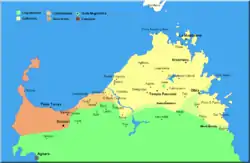
Sassarese derives from the Italian language and, more precisely, from ancient Tuscan, which by the 12th century had slowly grown to become the parlance of the commoners, at a time when the bourgeois and nobles still spoke Logudorese Sardinian. During the age of the Free Commune (1294 - 1323), the Sassarese dialect was nothing more than a contaminated Pisan, to which Sardinian, Corsican and Spanish expressions had been added; it is therefore not an indigenous dialect, but rather a continental one and, to be more specific, a mixed Tuscan dialect with its own peculiarities, and different from the Corsican-imported Gallurese.[18]
— Mario Pompeo Coradduzza, "Il sistema del dialetto", 2004, Introduction
The Gallurese variety is spoken in the extreme north of Sardinia, including the region of Gallura and the archipelago of La Maddalena, and Sassarese is spoken in Sassari and in its neighbourhood, in the northwest of Sardinia. Their geographical position in Sardinia has been theorised to be the result of successive migration waves from Tuscany and the already tuscanized Corsica, whose settlers had slowly displaced the Sardinian varieties spoken therein.
Although they both belong to the Italo-Dalmatian family, like Corsican but not Sardinian, it has long been a subject of debate whether the two should be included as dialects either in Corsican or in Sardinian or, in light of their historical development, considered independent languages. A classification has been proposed that they should all be placed in a single category, Southern Romance, but such proposal has not garnered universal support among linguists.
On the Maddalena archipelago, which was culturally Corsican but had been annexed to the Savoyard Kingdom of Sardinia a short while before Corsica was ceded by Genoa to France in 1767,[19] the local dialect (called isulanu or maddaleninu) was brought by fishermen and shepherds from Bonifacio over a long period of immigration in the 17th and 18th centuries. Though influenced by Gallurese, it has maintained the original characteristics of Southern Corsican. In the dialect of maddalenino, as it is known in Italian, there are also numerous words of Genoese and Ponzese origin.[20]
On October 14, 1997, Article 2 Item 4 of Law Number 26 of the Autonomous Region of Sardinia granted "al dialetto sassarese e a quello gallurese" equal legal status with the other languages on Sardinia. They are thus legally defined as different languages from Sardinian by the Sardinian government.[21]
Number of speakers
The January 2007 estimated population of Corsica was 281,000, whereas the figure for the March 1999 census, when most of the studies—though not the linguistic survey work referenced in this article—were performed, was about 261,000 (see under Corsica). Only a fraction of the population at either time spoke Corsican with any fluency.
The use of Corsican language over French language has been declining. In 1980 about 70 percent of the population of the island "had some command of the Corsican language."[22] In 1990 out of a total population of about 254,000 the percentage had declined to 50 percent, with only 10 percent using it as a first language.[5] (These figures do not count varieties of Corsican spoken in Sardinia.) The language appeared to be in serious decline when the French government reversed its unsupportive stand and initiated some strong measures to save it.
According to an official survey run on behalf of the Collectivité territoriale de Corse which took place in April 2013, in Corsica the Corsican language has a number of speakers between 86,800 and 130,200, out of a total population amounting to 309,693 inhabitants.[23] Only 28% of the overall population is able to speak Corsican well, whilst an additional 14% has a capacity to speak it "quite well". The percentage of those who have a solid oral understanding of the language varies between a minimum of 25 percent in the 25–34 age group and the maximum of 65 percent in the over-65 age group: almost a quarter of the former age group does not understand Corsican, while only a small minority of the older people do not understand it.[23] While 32 percent of the population of northern Corsica speaks Corsican quite well, this percentage drops to 22 percent for South Corsica.[23] Moreover, 10 percent of the population of Corsica speaks only French, while 62 percent speak both French and at least some Corsican.[23] However, only 8 percent of the Corsicans know how to write correctly in Corsican, while about 60 percent of the population does not know how to write in Corsican.[23] While 90 percent of the population is in favor of a Corsican-French bilingualism, 3 percent would like to have Corsican as the only official language in the island, and 7 percent would prefer French in this role.[23]
UNESCO classifies Corsican as a "definitely endangered language."[24] The Corsican language is a key vehicle for Corsican culture, which is notably rich in proverbs and in polyphonic song.
Governmental support
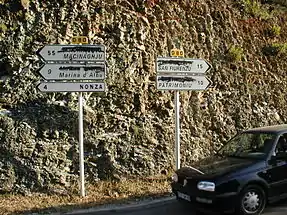
When the French Assembly passed the Deixonne Law in 1951, which made it possible for regional languages to be taught at school, Alsatian, Flemish and Corsican were not included on the ground of being classified as dialectes allogènes of German, Dutch and Italian respectively,[25] i.e. dialects of foreign languages and not languages in themselves.[26] Only in 1974 were they too politically recognized as regional languages for their teaching on a voluntary basis.
The 1991 "Joxe Statute", in setting up the Collectivité Territoriale de Corse, also provided for the Corsican Assembly, and charged it with developing a plan for the optional teaching of Corsican. The University of Corsica Pasquale Paoli at Corte, Haute-Corse took a central role in the planning.[27]
At the primary school level Corsican is taught up to a fixed number of hours per week (three in the year 2000) and is a voluntary subject at the secondary school level,[28] but is required at the University of Corsica. It is available through adult education. It can be spoken in court or in the conduct of other government business if the officials concerned speak it. The Cultural Council of the Corsican Assembly advocates for its use, for example, on public signs.
Literature
According to the anthropologist Dumenica Verdoni, writing new literature in modern Corsican, known as the Riacquistu, is an integral part of affirming Corsican identity.[29] Some individuals have returned from careers in continental France to write in Corsican, including Dumenicu Togniotti, director of the Teatru Paisanu, which produced polyphonic musicals, 1973–1982, followed in 1980 by Michel Raffaelli's Teatru di a Testa Mora, and Saveriu Valentini's Teatru Cupabbia in 1984.[30] Modern prose writers include Alanu di Meglio, Ghjacumu Fusina, Lucia Santucci, and Marcu Biancarelli.[31]
There were writers working in Corsican in the 1700s and 1800s.[32]
Ferdinand Gregorovius, a 19th-century traveller and enthusiast of Corsican culture, reported that the preferred form of the literary tradition of his time was the vocero, a type of polyphonic ballad originating from funeral obsequies. These laments were similar in form to the chorales of Greek drama except that the leader could improvise. Some performers were noted at this, such as the 1700s Mariola della Piazzole and Clorinda Franseschi.[33] However, the trail of written popular literature of known date in Corsican currently goes no further back than the 17th century.[34] An undated corpus of proverbs from communes may well precede it (see under External links below). Corsican has also left a trail of legal documents ending in the late 12th century. At that time the monasteries held considerable land on Corsica and many of the churchmen were notaries.
Between 1200 and 1425 the monastery of Gorgona, which belonged to the Order of Saint Benedict for much of that time and was in the territory of Pisa, acquired about 40 legal papers of various sorts related to Corsica. As the church was replacing Pisan prelates with Corsican ones there, the legal language shows a transition from entirely Latin through partially Latin and partially Corsican to entirely Corsican. The first known surviving document containing some Corsican is a bill of sale from Patrimonio dated to 1220.[35] These documents were moved to Pisa before the monastery closed its doors and were published there. Research into earlier evidence of Corsican is ongoing.
Alphabet and spelling
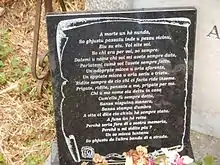
Corsican is written in the standard Latin script, using 21 of the letters for native words. The letters j, k, w, x, and y are found only in foreign names and French vocabulary. The digraphs and trigraphs chj, ghj, sc and sg are also defined as "letters" of the alphabet in its modern scholarly form (compare the presence of ch or ll in the old Spanish alphabet) and appear respectively after c, g and s.
The primary diacritic used is the grave accent, indicating word stress when it is not penultimate. In scholarly contexts, disyllables may be distinguished from diphthongs by use of the diaeresis on the former vowel (as in Italian and distinct from French and English). In older writing, the acute accent is sometimes found on stressed ⟨e⟩, the circumflex on stressed ⟨o⟩, indicating respectively (/e/) and (/o/) phonemes.
Corsican has been regarded as a dialect of Italian historically, similar to the Romance lects developed on the Italian peninsula, and in writing, it also resembles Italian (with the generalised substitution of -u for final -o and the articles u and a for il/lo and la respectively; however, both the dialect of Cap Corse and Gallurese retain the original articles lu and la). On the other hand, the phonemes of the modern Corsican dialects have undergone complex and sometimes irregular phenomena depending on phonological context, so the pronunciation of the language for foreigners familiar with other Romance languages is not straightforward.
Phonology
Vowels
As in Italian, the grapheme ⟨i⟩ appears in some digraphs and trigraphs in which it does not represent the phonemic vowel. All vowels are pronounced except in a few well-defined instances. ⟨i⟩ is not pronounced between ⟨sc/sg/c/g⟩ and ⟨a/o/u⟩: sciarpa [ˈʃarpa]; or initially in some words: istu [ˈstu].[36]
Vowels may be nasalized before ⟨n⟩ (which is assimilated to ⟨m⟩ before ⟨p⟩ or ⟨b⟩) and the palatal nasal consonant represented by ⟨gn⟩. The nasal vowels are represented by the vowel plus ⟨n⟩, ⟨m⟩ or ⟨gn⟩. The combination is a digraph or trigraph indicating the nasalized vowel. The consonant is pronounced in weakened form. The same combination of letters might not be the digraph or trigraph but might be just the non-nasal vowel followed by the consonant at full weight. The speaker must know the difference. Example of nasal: ⟨pane⟩ is pronounced [ˈpãnɛ] and not [ˈpanɛ].
The Northern and central dialects in the vicinity of the Taravo river adopt the Italian seven-vowel system, whereas all the Southern ones around the so-called "archaic zone" with its centre being the town of Sartène (including the Gallurese dialect spoken in Northern Sardinia) resort to a five-vowel system without length differentiation, like Sardinian.[37]
The vowel inventory, or collection of phonemic vowels (and the major allophones), transcribed in IPA symbols, is:[38][39]
| Description | Grapheme (Minuscule) |
Phoneme | Phone or Allophones |
Usage | Example |
|---|---|---|---|---|---|
| Open front unrounded Near open |
a | /a/ | [a] [æ] |
Occasional northern |
casa [ˈkaza] house carta [ˈkærta] card |
| Close-mid front unrounded Open-mid Near-open Open |
e | /e/ | [e] [ɛ] [æ] [a] |
Inherited as open or close Occasional northern Occasional southern |
u celu [uˈd͡ʒelu] the sky ci hè [ˈt͡ʃɛ] there is mercuri ['mærkuri] wednesday terra [ˈtarra] land |
| Close front unrounded | i | /i/ | [i] [j] |
1st sound, diphthong |
dì ['di] say fiume [ˈfjumɛ] river |
| Close-mid back rounded Open-mid |
o | /o/ | [o] [ɔ] |
Inherited as open or close |
locu [ˈlogu] place notte [ˈnɔtɛ] night |
| Close back rounded | u | /u/ | [u] [w] [ɥ] |
1st sound, diphthong |
malu [ˈmalu] bad quassù [kwaˈsu] up there què [ˈkɥɛ] that |
Sample of text
|
Sono nato in Corsica e ci ho passato gli anni migliori della mia giovinezza. |
Sò nato in Corsica e c'hajo passato li méglio anni de la mi' giovinezza. |
Sò natu in Corsica è c'aghju passatu i più belli anni di a mio giuventù. |
Sòcu natu in Còrsica e v'agghju passatu i mèddu anni di a me ghjuvintù. |
Sòcu natu in Còssiga e v'agghju passatu li mèddu anni di la mè ciuintù. |
Soggu naddu in Còssiga e v'aggiu passaddu li megli'anni di la me' pizzinìa. |
|
Ricordo, quando eravamo ragazzi, che le nostre mamme ci mandavano da soli a fare il bagno. |
Mi mentovo, quand'èremo bàmboli, che le nosse ma' ci mandàveno da ssoli a fa' 'l bagno. |
M'arricordu, quand'èramu zitelli, chì e nostre mamme ci mandavanu soli à fà u bagnu. |
M'ammentu, quand'érami zitéddi, chì i nosci mammi ci mandàiani da par no' a fàcci u bagnu. |
M'ammentu, candu érami stéddi, chi li nostri mammi ci mandàani da pal noi a fàcci lu bagnu. |
M'ammentu, cand'érami minori, chi li nosthri mammi zi mandàbani a fazzi lu bagnu a la sora. |
|
Allora la spiaggia era piena di sabbia, senza scogli né rocce e si stava in mare delle ore fino a quando, paonazzi dal freddo poi ci andavamo a rotolare in quella sabbia bollente dal sole. |
Allora la piaggia era piena di rena, senza scogli né greppe e stàvemo in mare fino a quando, ingrozzichiti, c'andàvemo a rivorta' 'n chidda rena bollente dal sole. |
Tandu a piaghja era piena di rena, senza scogli né cotule é ci ne stàvamu in mare per ore fin'à quandu, viola per u freddu, dopu ci n'andavamu a vultulàcci in quella rena bullente da u sole. |
Tandu a piaghja ghjéra piena di rèna, senza scódda né ròcchi è si staghjìa in mari ori fin'a quandu, viola da u fritu, andàghjìami a vultulàcci in quidda rèna buddènti da u soli. |
Tandu la piaghja éra piena di rèna, senza scóddi e né ròcchi e si stagghjìa in mari ori fin'a candu, biaìtti da lu fritu, andaghjìami a vultulàcci in chidda rèna buddènti da lu soli. |
Tandu l'ippiaggia era piena di rena, chena ischogliu né rocca e si isthazzìa a mogliu ori finz'a candu, biaìtti da lu freddu, andàbami a busthurazzi in chidda rena buddendi da lu sori. |
|
Poi l'ultimo tuffo per levarci la sabbia attaccata alla pelle e ritornavamo a casa che il sole era già calato, all'ora di cena. |
Poi l'urtimo ciutto pe' levacci la rena attaccata a la pella e tornàvemo 'n casa che 'l sole era già ciuttato, a l'ora di cena. |
Po' l'ultima capiciuttata per levacci a rena attaccata à a pelle è vultavamu in casa chì u sole era digià calatu, à ora di cena. |
Dapo', l'ultima capuzzina pa' livàcci a réna attaccata a à péddi e turràiami in casa chì u soli era ghjà calatu, à l'ora di cena. |
Dapoi, l'ultima capuzzina pa' bucàcci la réna attaccata a la péddi e turràami in casa chi lu soli éra ghjà calatu, a l'ora di cena. |
A dabboi, l'ùlthimu cabuzzoni pa bugganni la rena appizzigadda a la peddi e turràbami a casa chi lu sori era già caraddu, a l'ora di zinà. |
|
Quando faceva buio, noi ragazzi ci mandavano a fare granchi, con la luce, che serviva per mettere l'esca agli ami per pescare. |
Quando veniva buio, a no' bàmboli ci mandàveno a fa' granchi, colla luce, che ci voléveno pe' mette' l'ami pe' pescà. |
Quand'ellu facìa bughju, à noi zitèlli ci mandàvanu à fà granchi, cù u lume, chì ci vulìa per innescà l'ami per a pesca. |
Quandu facìa bughju, à no' zitéddi ci mandàiani à fà granci, cù a luci, chi ci vulìa par inniscà l'ami pà piscà. |
Candu facìa bugghju, a noi stéddi ci mandàani a fa' granchi, cù la luci, chi vi vulìa pa' accindì (attivà) l'ami pa' piscà. |
Candu si fazìa buggiu, a noi pizzinni zi mandàbani a piglià granchi, cu' la luzi, chi vi vurìa pa innischà l'amu pa pischà. |
|
Ne raccoglievamo in quantità, poi in casa li mettevamo in un sacchetto chiuso in cucina. |
Ne aricogliévemo a guaro, po' 'n casa li mettévemo in de 'n sacchetto chiuso 'n cucina. |
N'arricuglìamu à mandilate piene, po' in casa i punìamu nu un sacchéttu chjosu in cucina. |
N'arricuglivàmi à mandili pieni, è dapoi in casa i mittìami drent'à un sacchettu chjusu in cucina. |
N'accapitàami a mandili pieni, e dapoi in casa li mittìami indrent'a un sacchéddu chjusu in cucina. |
Ni pigliàbami umbè, e dabboi in casa li punìami drentu a un sacchettu sarraddu i' la cuzina. |
|
Una mattina in cui ci eravamo alzati che era ancora buio, quando siamo andati a prendere il sacchetto era vuoto e i granchi giravano per tutte le camere, e c'è voluta più di mezz'ora per raccoglierli tutti. |
Una matina che c'èremo levati ch'era sempre buio, quando simo andati a piglià 'l sacchetto era voto e li granchi giràveno pe' tutte le càmmere, e c'è voluto più di mezz'ora ad aricoglieli tutti. |
Una mane chì c'èramu arritti ch'èra sempre bughju, quandu simu andati à piglià u sacchettu ellu èra biotu è i granchi giravanu per tutte e camere, è ci hè vulsuta più di méz'ora à ricoglieli tutti. |
Una matìna chì ci n'érami pisàti chi ghjéra sempri bughju, quandu sèmu andati à piddà u sacchéttu iddu éra biotu è i granci ghjiràiani pà tutti i càmari, e ci hè vuluta più di méz'ora pà ricapizzulàlli tutti. |
Una matìna chi ci n'érami pisàti chi éra sempri lu bugghju, candu sèmu andati a piddà lu sacchéddu iddu éra bòitu e li granchi ghjràani pa' tutti li càmbari, e v'è vuluta più di mez'ora pa' accapitàlli tutti. |
Un manzanu chi zi n'érami pisaddi chi era ancora buggiu, candu semmu andaddi a piglià lu sacchettu eddu era bioddu e li granchi giràbani pa tutti li càmmari, e v'è vurudda più di mezz'ora pa accuglinniri tutti. |
See also
- Corsican Wikipedia
- Gallurese dialect
- Languages of France
- Sassarese language
References
- Corsican at Ethnologue (23nd ed., 2020)
- Harris, Martin; Vincent, Nigel (1997). The Romance Languages. London: Routledge. ISBN 0-415-16417-6.
- Endangered Languages Project data for Corsican.
- "UNESCO Atlas of the World's Languages in danger". www.unesco.org. Retrieved 18 March 2018.
- "Corsican in France". Euromosaic. Retrieved 2008-06-13. To access the data, click on List by languages, Corsican, Corsican in France, then scroll to Geographical and language background.
- "Ciurrata Internaziunali di la Linga Gadduresa" (PDF). (in Gallurese).
- Giovanni Battista Pellegrini (1977). Carta dei dialetti d'Italia. Pisa: Pacini. p. 30-34.
- "Corsica". Britannica.
- "Distribution of the Romance languages in Europe". Britannica.
- Cortelazzo, Manlio (1988). Gliederung der Sprachräume/Ripartizione dialettale, in Lexikon der Romanistischen Linguistik (LRL), edited by G. Holtus, M. Metzeltin e C. Schmitt, vol. IV, Tübingen, Niemeyer, pg. 445-453
- <<It may come as a surprise that the closest [linguistic] neighbor is not Sardinian, even if it is so close geographically. The closest neighbor is to be found in meridional Italy, especially in Calabrian. A Southern Corsican, speaking Corsican in Tuscany, will be identified as being Calabrian; a Northern Corsican, speaking Corsican in inner Sardinia, will be identified as being Italian; and, finally, a Sardinian speaking Sardinian in the [Italian] peninsula would not be understood at all.>> Original quote: <<On sera peut-être surpris de constater que la plus proche parenté n'est pas avec le sarde, pourtant si proche dans l'espace, mais avec les dialectes de l'Italie méridionale, notamment le calabrais. Un Corse du Sud parlant corse en toscane sera identifié comme calabrais; un corse du nord parlant corse en Sardaigne centrale sera identifié comme italien; quand à un sarde parlant sarde dan la péninsule, il ne sera pas compris.>> Fusina, Ghjacumu; Ettori, Fernand (1981). Langue Corse Incertitudes et Paris, Ajaccio, Scola Corsa, pg.12
- <<Pendant des siècles, toscan et corse ont formé un couple perçu par les locuteurs comme deux niveaux de la même langue.>> Fusina, Ghjacumu; Ettori, Fernand (1981). Langue Corse Incertitudes et Paris, Ajaccio, Scola Corsa, pg.81
- Arrighi, Jean-Marie (2002). Histoire de la Corse, Edition Jean-Paul Gisserot, Paris, pg.51
- Toso, Fiorenzo. Lo spazio linguistico corso tra insularità e destino di frontiera, Università di Udine
- Blackwood, Robert J. (August 2004). "Corsican distanciation strategies: Language purification or misguided attempts to reverse the gallicisation process?". Multilingua – Journal of Cross-Cultural and Interlanguage Communication. 23 (3): 233–255. doi:10.1515/mult.2004.011.
- Jehasse, Olivier. Corsica in Etruscology (Edited by Alessandro Naso), 2017
- Sardinian language, Encyclopedia Britannica
- «Il sassarese deriva dalla lingua italiana e, più precisamente, dal toscano antico, poi trasformatosi lentamente in dialetto popolare fin dal secolo XII, quando ancora i borghesi e i nobili parlavano in sardo logudorese. Durante l'età del Libero Comune (1294 - 1323), il dialetto sassarese non era altro che un pisano contaminato, al quale si aggiungevano espressioni sarde, corse e spagnole; non è quindi un dialetto autoctono, ma continentale e, meglio determinandolo, un sotto - dialetto toscano misto, con caratteri propri, diverso dal gallurese di importazione corsa.»
- Giovanna Sotgiu. "La Maddalena nella storia". Official website of the Maddalena Commune.
- For more information, see Renzo de Martino (1996). Il dialetto maddalenino. Storia, grammatica, genovesismi. Il dialetto corso. Edizioni della Torre.
- Autonomous Region of Sardinia (1997-10-15). "Legge Regionale 15 ottobre 1997, n. 26" (in Italian). pp. Art. 2, paragraph 4. Retrieved 2008-06-16.
- "Corsican language use survey". Euromosaic. Retrieved 2008-06-13. To find this statement and the supporting data click on List by languages, Corsican, Corsican language use survey and look under INTRODUCTION.
- "Inchiesta sociolinguistica nant'à a lingua corsa". www.corse.fr (in Corsican). Collectivité territoriale de Corse. Retrieved 4 December 2014.
- Moseley, Christopher (ed.). 2010. Atlas of the World's Languages in Danger, 3rd edn. Paris, UNESCO Publishing. Here is the online version
- Delamotte-Legrand, Régine; François, Frédéric; Porcher, Louis (1997). Langage, éthique, éducation: Perspectives croisées, Publications de l'Université de Rouen et du Havre
- Sibille, Jean (2019-11-14), Pailhé, Joël; Viaut, Alain (eds.), "« Langues de France » et territoires : raison des choix et des dénominations", Langue et espace, Multilinguisme et langues minoritaires, Pessac: Maison des Sciences de l’Homme d’Aquitaine, pp. 85–107, ISBN 978-2-85892-522-3, retrieved 2020-12-11
- Daftary, Farimah (October 2000). "Insular Autonomy: A Framework for Conflict Settlement? A Comparative Study of Corsica and the Åland Islands" (PDF). European Centre For Minority Issues (ECMI). pp. 10–11. Archived from the original (PDF) on 2008-10-02. Retrieved 2008-06-13.
- (French) Dispositif académique d’enseignement de la langue corse dans le premier degré, année scolaire 2010–2011, Academy of Corsica
- Verdoni, Dumenica. "Etat/identités:de la culture du conflit à la culture du projet". InterRomania (in French). Centru Culturale Universita di Corsica. Archived from the original on 2008-05-11. Retrieved 2008-06-17.
- Magrini, Tullia (2003). Music and Gender: Perspectives from the Mediterranean. University of Chicago Press. p. 53. ISBN 0-226-50166-3.
- Filippi, Paul-Michel (2008). "Corsican Literature Today". Transcript (17). Archived from the original on 2008-04-05. Retrieved 2008-06-26.
- "Auteurs". ADECEC.net. Archived from the original on 27 June 2008. Retrieved 2008-06-28.
- Gregorovius, Ferndinand (1855). Corsica in Its Picturesque, Social, and Historical Aspects: the Records of a Tour in the Summer of 1852. Russell Martineau (trans.). London: Longman, Brown, Green and Longmans. pp. 275–312.
- Beretti, Francis (Translator) (2008). "The Corsican Language". Transcript (17). Archived from the original on 2008-04-05. Retrieved 2008-06-29.
- Scalfati, Silio P. P. (2003). "Latin et langue vernaculaire dans les actes notariés corses XIe-XVe siècle". La langue des actes. XIe Congrès international de diplomatique (Troyes, 11–13 September 2003). Éditions en ligne de l'École des chartes. Retrieved October 30, 2011.
- "La prononciation des voyelles". A Lingua Corsa. April 19, 2008. Retrieved 2008-06-20.
- "corsi, dialetti in "Enciclopedia dell'Italiano"". www.treccani.it. Retrieved 18 March 2018.
- Fusina, Jacques (1999). Parlons Corse. Paris: L'Harmattan.
- "Notes sur la phonétique utilisée sur ce site". A Lingua Corsa. April 19, 2008. Retrieved 2008-06-20.
Bibliography
- Jaffe, Alexandra (1999). Ideologies in Action: Language Politics on Corsica. Walter de Gruyter. ISBN 3-11-016445-0.
External links
| Corsican edition of Wikipedia, the free encyclopedia |
| Wikimedia Commons has media related to Corsican language. |
| Wikiversity has learning resources about Corsican language |
| Wikivoyage has a phrasebook for Corsican. |
- Corsican language, alphabet and pronunciation
- "INFCOR: Banca di dati di a lingua corsa". L'ADECEC (Association pour le Développement des Etudes Archéologiques, Historiques, linguistiques et Naturalistes du Centre-Est de la Corse). Retrieved 2008-06-13.
- "Patre Nostru". prayer.su. Retrieved 2008-06-25.
- "Traduction Corse – Latin". A lingua corsa. Retrieved 2008-06-13.